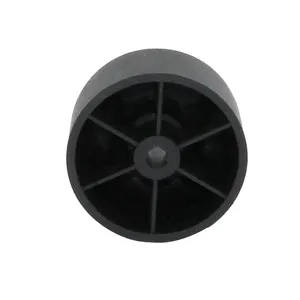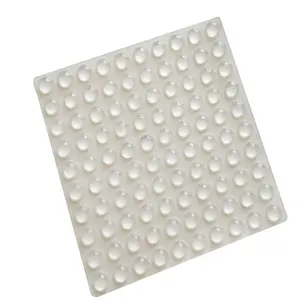
All categories
Featured selections
Trade Assurance
Buyer Central
Help Center
Get the app
Become a supplier

(873 products available)




















































Small rubber feet come in various types, each designed for specific applications. Depending on one's requirement, these types differ in shape, attachment method, and cushioning properties.
Round rubber feet, often manufactured using silicone rubber, are the most commonly used in appliances. Their symmetrical shape makes them ideal for even load distribution. Round rubber feet support components like electronics, furniture, and small machinery.
Square rubber feet, typically using natural rubber, offer a stable and secure mounting base. The flat, angular design suits applications where a broader surface area is needed. Square rubber feet are routinely found in mounting systems, industrial machines, and storage equipment.
Peg and hole feet incorporate a peg on one side that fits into a corresponding hole on the opposing component. These detachable feet offer secure yet accessible mounting. Peg and hole feet frequently feature in modular furniture and mobile equipment.
Dome-shaped rubber feet perform a cushioning function. These slightly raised, soft-capped feet dampen vibrations and shock. Dome-shaped feet serve audio equipment and fragile instruments by providing additional safety.
Adhesive-backed rubber feet come with a sticky backing layer for easy attachment. These are temporary or semi-permanent solutions for cushioning use in various applications. They are found in devices where non-permanent application is feature, like in electronics and home appliances.
Small rubber feet prove critical in ensuring smooth operations across diverse industrial settings. It enhances machinery longevity, minimizes noise pollution, safeguards sensitive devices, and maintains Z.
Small rubber feet are commonly employed on heavy-duty machinery like compressors and pumps. They absorb vibrations during equipment operation, lessening transmission to floors and nearby structures. This damping reduces noise levels and protects sensitive components and parts from damage or misalignment.
Rubber feet are crucial for shock absorption in transit packaging for fragile products like glassware. They provide cushioning between surfaces to minimize impact during shipping, protecting items from damage. As a result, many industries, including electronics and glass manufacturers, rely on small rubber feet in protective packaging.
In automobiles, small rubber feet play a prominent role in securing battery mounts, mirrors, and interior components. They dampen vibrations, giving a smoother ride and protecting the vehicle's electronic systems from interference. Rubber feet also help lessen road noise, improving passenger comfort in a vehicle.
In power tools and hardware, small rubber feet give stability when the device is placed on different surfaces. They prevent slippage and scratching on workspace areas, including garages or professional workshops. Moreover, the cushioning effect of rubber feet prolongs tool life by minimizing fatigue on internal components caused by consistent use.
Rubber feet avoid scratching when industrial carts, racks, or cabinets come into direct contact with treated wood or laminate flooring. They also assist in leveling these systems in uneven flooring conditions to promote stability. Rubber feet on industrial furniture prevent corrosion over the years by separating metal components from damp concrete surfaces.
Small rubber feet are slow to receive modifications based on performance, aesthetics, and the requirements of different industries. Customizing them makes it easy to find the right solution and avoid using some products forever.
Rubber foot materials determine functionality and durability. Further, custom options allow for selecting hardness levels or durometers based on requirements. Silicone rubber provides superior heat and weather resistance, while nitrile rubber offers excellent chemical and oil tolerance. Such flexibility ensures the feet can work effectively in high-temperature environments or exposed to specific industrial substances.
Standard small rubber foot sizes might not suit particular applications. Customization options for dimensions allow businesses to request specific diameters, heights, or shapes. This provides the necessary support or cushioning in specific devices or machinery. In addition, such precision in size results in improved performance and efficient space utilization.
Color coding makes identification less of a problem. Nonetheless, standard colors as black, grey, and white have less to offer. Thanksfully, customization options for colors, branding, and aesthetic designs make it possible to choose specific shades. They also help reinforce a brand or make an appliance look better. Material surfaces assist anti-bacterial coating, making them easier to clean.
Specific applications might require special features in small rubber feet. For instance, industries that deal with high-frequency heating, such as food processing, could use conductive silicone rubber for better thermal Dissipation. Medical equipment feet might also need anti-microbial treatment to reduce germs or bacteria. Aerospace components could require rubber feet made from highly durable polymers to resist harsh environmental influences.
The durometer or hardness grade of rubber feet is critical because it determines the flexibility and strength of the feet. For instance, low-hardness rubber feet cushion shock and noise. On the other hand, high-hardness variants ensure better load-carrying capacity and wear endurance. Custom durometers are highly recommended so the existing clients can better their products.
Several factors should be considered when picking small rubber feet. Here are some of them:
The choice of material impacts the rubber feet's performance, durability, and cost. In addition, natural rubber is popular because of its elasticity and strength, while silicon rubber is heat resistant. Nitrile rubber is oil and chemical resistant, while thermoplastic elastomers have plastics properties. Remember to choose one that meets the requirement.
How and where the small rubber feet are intended to be utilized mostly determine the type to use. For instance, adhesive-backed feet apply in electronics to avoid slipping. Peg and hole should be used where detachable features are necessary. Then, in shock-absorbing and dampening equipment, the dome-shaped or conductive silicone feet should be applied.
Below are some load capacities of rubber feet:
The feet must handle these pressures well. Ensure the correct size of rubber feet carries the load, both static and dynamic, it usually carries in a particular application.
Round and dome-shape rubber feet are ideal for uniform load distribution due to shape. However, square feet are better when more surface area is required. Peg and hole are for modular applications. The size ensures the proper load-carrying capability. Remember, the bigger the size, the bigger the chances of better functionality. But the products should also have enough space.
Durometers measure rubber feet hardness. Then, softer rubber feet provide flexibility and better shock absorption. Conversely, harder feet offer durability and load capacity. To put it in simple words, softer feet provide flexibility, while harder ones are durable and bear a load.
Rubber foot commonly uses natural rubber due to elasticity and strength. Silicone rubber, although slightly more expensive, adds heat and weather resistance. Nitrile rubber, known for chemical and oil resistance, is popular among industrial uses. Lastly, thermoplastic elastomers combine plastic properties for easy molding and reusability.
Small rubber feet play a vital role in noise reduction. In the industrial setting, for instance, it may help vibrate the tools to avoid transmitting sound to the floor or the surrounding structure. Therefore, equipment noise level is lowered, providing a more pleasant working atmosphere.
Yes, they are customizable. Various features, such as hardness, color, size, and material, can be adjusted. This customization enables them to cater to specific application requirements, ensuring optimal performance and use.
One must consider the specific application requirements. Plus, softer ratings better provide flexibility and shock absorption. Conversely, the harder figures provide load-bearing capacity and durability. It, therefore, ensures that the rating matches the usage to maximize the feet's functionality.
Small rubber feet are cost-effective, easy to install, and versatile compared to mounting systems and pads. However, while they offer basic vibration-damping and cushioning functions, other solutions, such as pneumatic mounts, could efficiently handle more complex applications.